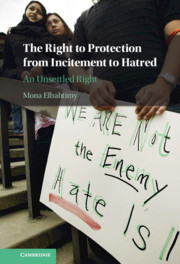
-
Select format
-
- Publisher:
- Cambridge University Press
- Publication date:
- October 2021
- October 2021
- ISBN:
- 9781108946490
- 9781108837569
- Dimensions:
- (229 x 152 mm)
- Weight & Pages:
- 0.49kg, 232 Pages
- Dimensions:
- Weight & Pages:
- Subjects:
- Public International Law, Law, Human Rights
You may already have access via personal or institutional login- Subjects:
- Public International Law, Law, Human Rights
Book description
Against the backdrop of the new globalized hate speech dynamics, the nature and scope of States' obligations pursuant to international human rights law on prohibiting incitement to hatred have taken on increased importance and have become a controversial issue within multilateral human rights diplomacy. Key questions being posed in the on-going debates over how best to respond to the new wave of hatred include whether the international legal norm against incitement to hatred, as it currently stands, is suitable to address the contemporary challenges of this phenomenon. Alternatively, does it need to be developed further? This book traces the journey of this norm in three analytical domains; its emergence, relevant supranational jurisprudence, and the recent standard-setting attempts within the UN. The book argues that five internal features of the norm had a strong influence on its difficult path within international human rights law.
Contents
Metrics
Altmetric attention score
Full text views
Full text views help Loading metrics...
Loading metrics...
* Views captured on Cambridge Core between #date#. This data will be updated every 24 hours.
Usage data cannot currently be displayed.
Accessibility standard: Unknown
Why this information is here
This section outlines the accessibility features of this content - including support for screen readers, full keyboard navigation and high-contrast display options. This may not be relevant for you.
Accessibility Information
Accessibility compliance for the PDF of this book is currently unknown and may be updated in the future.


